Blue Heaven
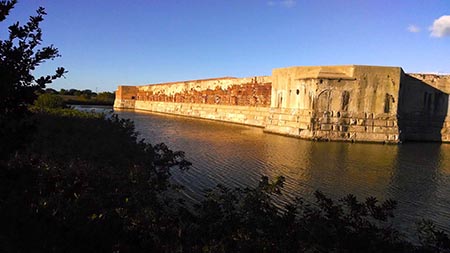
The breakfast dishes are cleaned up; the long sleeve t-shirt put away from the dawn’s mild coolness; pictures taken yesterday are edited and posted.
I need to get on the story, but preferred to let the color blue rush over me as the light changed, illuminating the square of the skylight.
The color blue has been with me of late. The marvelous rich sky, the paler blue of the Florida Straits…the faded blue of the sign jutting from the apex of the Blue Heaven bar, where Uncle Ernie used to ref boxing matches long ago.
Blue water, blue sky. A little blue emotion, too, thinking about what had been and what is to be.
To be, or not to be? Hamlet said that, and Sinatra answered across the centuries: Do be, do be, do.
So I did. I plodded over to Fort Zachary Taylor yesterday. Uncle Sam has been here a long time, not as long as the Spanish, of course (1516), but what we took with Florida were these marvelous islands in the sun. Key West is the end of the line for US-1, of course, but the isles continue on to the Dry Tortugas, and the magnificent brick walls of Fort Jefferson. I want to get out there, but may not make it this trip.
The closest thing handy is Fort Taylor, and that is where I headed after an abortive attempt to find a television that does not have to be hooked to a cable. I remember there were such things, and television, limited to a few channels, was just fine.
I heard on my clock radio that the Navy would be participating in some Homeland Security Drill, and would be manning the guard posts that protect access to the bastions of the Navy Exchange Gas Station, the Commissary and Exchange itself.
Being away from Washington, I thought I would try to just avoid the whole Homeland Security thing, but it really is a persistent issue here. The transition from Spanish to American rule is a complex topic, as is completely appropriate for an island whose heroes are pirates.
When England grabbed Florida in 1763, the Spanish contended that the Keys were a component of what they called “Habana Norte.” On March 25, 1822, Navy LCDR Matthew C. Perry sailed the US schooner Shark to Key West, surveyed the island and planted the U.S. flag.
The Spanish were not in a position to do anything about it, and there the matter rested. The real homeland security problem was piracy. Washington dispatched Commodore David Porter with a cool half-million dollars to establish an anti-terror task force- maybe I am updating the terminology, but that is essentially the seascape of the time
For some it was difficult to determine who disliked Commodore Porter more, the pirates or the residents of Key West, then known as “Thompson’s Island.”
Porter lost his command in 1825 due to accusations that he had exceeded his discretionary authority by invading Puerto Rico, which we would not seriously get around to until 1898. In 1826 the Navy moved the Navy base to Florida’s panhandle at Pensacola. A coal bunker and supply depot remained at Key West.
The raffish nature of the city was well established due to natural selection. The Strait of Florida was crucial to navigation of the Gulf Stream. During the heyday of the Age of Sail, a hundreds ships would pass by the island, with as many as one per week succumbing to the treacherous waters. The plunder in the shallow water sparked a tradition of wrecking-and-salving that went on for a hundred years and made Key West a wealthy place.
Key West became a “Port of Entry” for wrecks in the region in 1828 (see the Federal Wrecking Act of 1825 if you are curious) and the processing and selling of salvaged property became a primary economic activity. The Navy never has been very good about strategic thinking: after the Pirates were cleaned out, the Service turned its attentions elsewhere.
The Department of the Army had a different view. The Corps of Engineers was tasked with completing the vision of President Jefferson that the territory of the United States ought to be protected from predation. A chain of brick forts, most of them multi-storied bastions of masonry, were strung all along the East Coast.
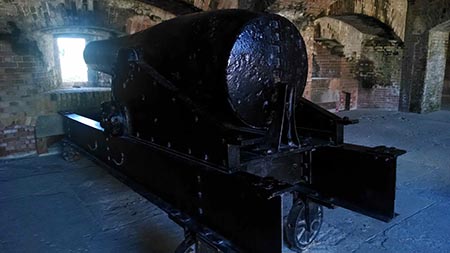
At Key West, the building of a three-story brick fort began in 1845, and was mostly incomplete due to the damage caused by the big storm in 1846 when President Zachary Taylor is died in office in 1850. The facility was named in his honor, and became a bastion for the Union Forces when Florida joined the Confederacy in 1861.
The fort was impregnable, and never seriously challenged by the Rebels. Key West became home to the Union Gulf Blockade Squadron, After the Civil War, the Navy basically abandoned it’s facilities a surplus to the cigar and sponge industries. Armored Cruiser- 1 USS Maine departed Key West on the fateful “humanitarian” mission that resulted in the loss of the ship and most of her crew in Havana Harbor. Some of her sailors lie a few blocks up Angela Street.
The Fort was considered obsolete by the time hostilities broke out in Europe in 1914, and an effort to cut down the high profile of the ramparts undertaken. In the process, thousands of tons of bricks were ripped out, and the old cannon buried in the old foundations to support modern coastal artillery.
Anyway, after the last active service in the Cuban Missile Crisis, the Department of the Navy abandoned ship again, and a small rump of a base is left, and Fort Zachary Taylor was handed over to the Park Service, along with a perfectly serviceable beach. All that is quite apart from my mission to go find the fort, and get acquainted with it.
I trudged down Angela as the light was getting long. The Sentries had been re-posted while I was getting gas and at the Exchange, and I needed to get it in gear if I was going to do anything significant with the rest of the day.
It was so nice that I took off my shirt as I walked along, putting it back on as I navigated the discontinuity of the streets around what had been the wall of the old Naval Station. There were some curious structures onboard the property of the Truman Annex, and I considered seeing if my ID card would get me in. The legs ached, but I figured I had hobbled far enough that a little more pain would be tolerable.
I passed through the Park Service Gate and trudged up the access road to the fort, and the beach.
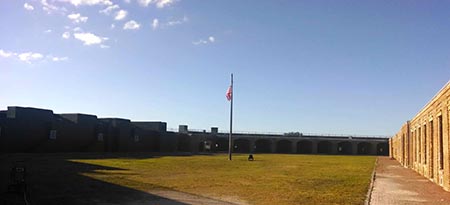
There were some tourists leaving as I arrived, and I had the place to myself for a half hour until two formidable Ranger arrived to toss me out.
Really a cool structure. So cool, that I thought it would be appropriate to transition from historical research to literary, which is how I wound up in a conversation with Mike from Cleveland, a young man with dark good looks and an aquiline nose who was tending bar in the courtyard of Blue Heaven, which must have been the closest bar to the Navy Base back in the day. It was old enough, in its original incarnation, that the sailors of the Maine might very well have had their last non-regulation tot of rum right there.
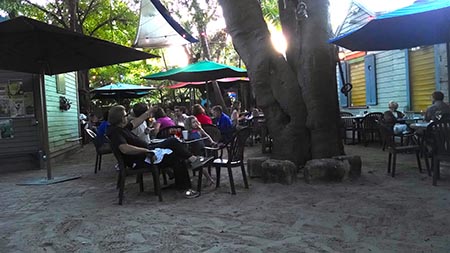
“Do you know anything about the boxing?” I asked him.
“About boxing? Sure, I know about boxing.” y
“No, I meant the boxing that happened here.”
“Oh, that. Sure. The open space under the tree behind you is where they used to have a ring. This place has been a lot of things: whore house, cock-fight palace, Speak-easy. Not with the current owners, though.”
“Understood. Every place has its story. But is it true that Earnest Hemingway used to referee some of the bouts?” I asked.
“Yep. Right there, he said, pointing to the tables under the tree.” Behind Mike a little girl and her brother were trying to work a hula hoop and almost succeeding. The light turned briefly sapphire, and then dimmed.
I managed to divide a twenty between drinks and a tip, and told Mike I would be seeing him again. He shrugged, and said that would be fine.
As I walked up to Duval in the azure night, I got the real sense that this is the beginning of something new, and also the continuation of something old, brought to the surface by the rushing blue water.
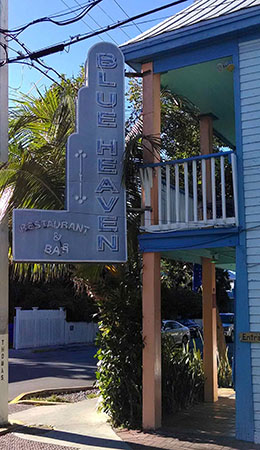
Copyright 2014 Vic Socotra
www.vicsocotra.com
Twitter: @jayare303
